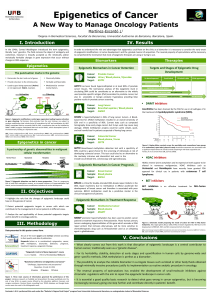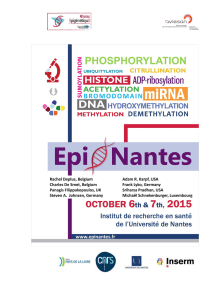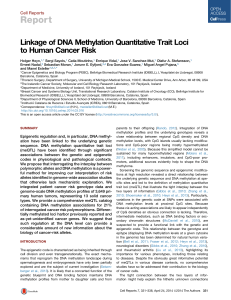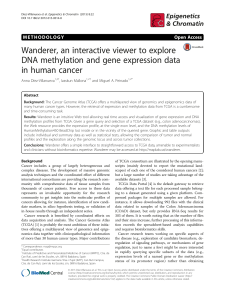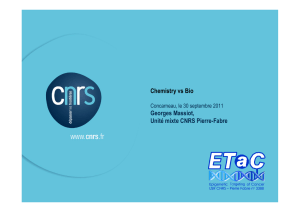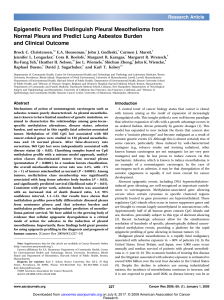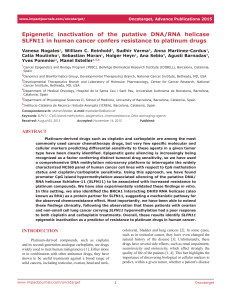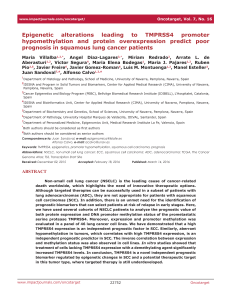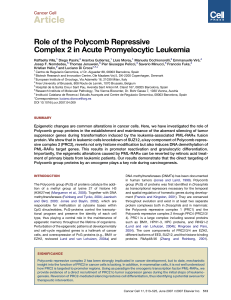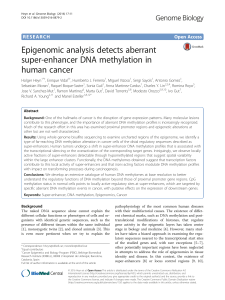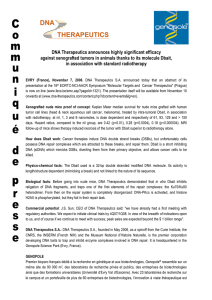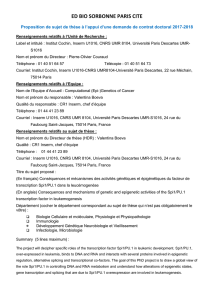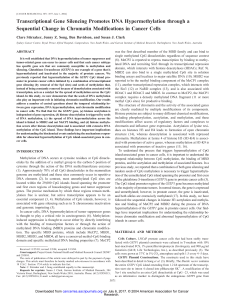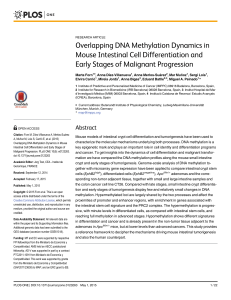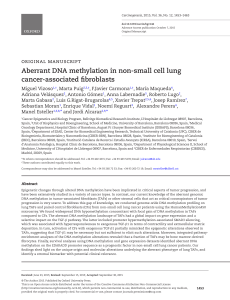Review Article Epigenetic Studies in Human Diseases J. HALUŠKOVÁ
publicité
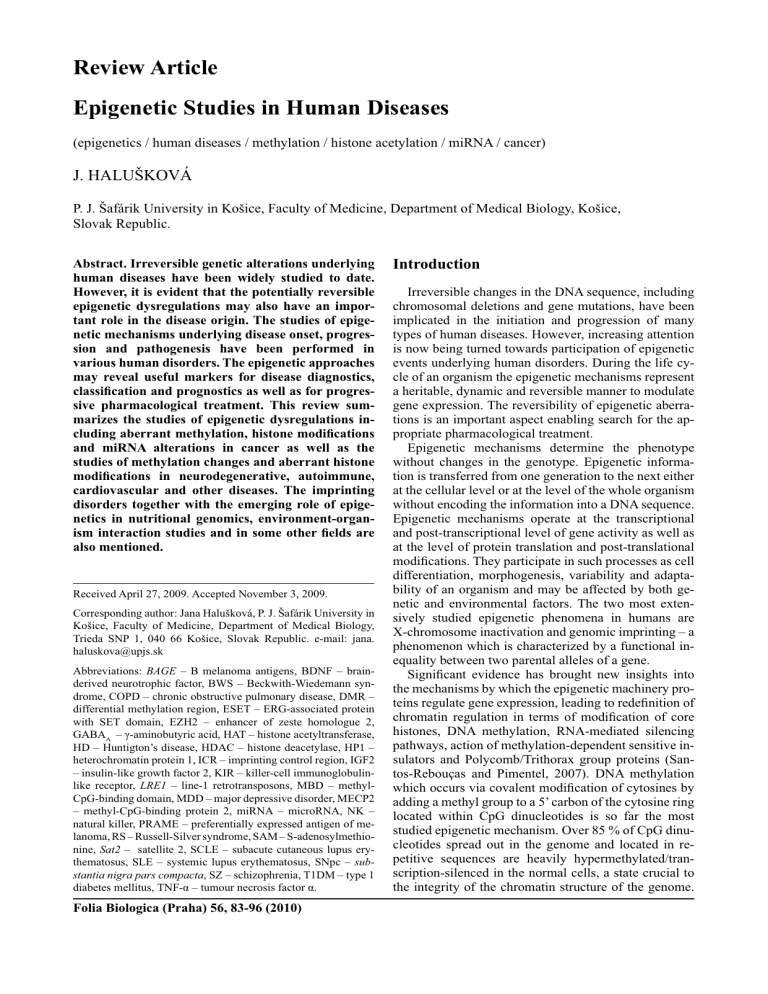
Review Article Epigenetic Studies in Human Diseases (epigenetics / human diseases / methylation / histone acetylation / miRNA / cancer) J. HALUŠKOVÁ P. J. Šafárik University in Košice, Faculty of Medicine, Department of Medical Biology, Košice, Slovak Republic. Abstract. Irreversible genetic alterations underlying human diseases have been widely studied to date. However, it is evident that the potentially reversible epigenetic dysregulations may also have an important role in the disease origin. The studies of epigenetic mechanisms underlying disease onset, progression and pathogenesis have been performed in various human disorders. The epigenetic approaches may reveal useful markers for disease diagnostics, classification and prognostics as well as for progressive pharmacological treatment. This review summarizes the studies of epigenetic dysregulations including aberrant methylation, histone modifications and miRNA alterations in cancer as well as the studies of methylation changes and aberrant histone modifications in neurodegenerative, autoimmune, cardiovascular and other diseases. The imprinting disorders together with the emerging role of epigenetics in nutritional genomics, environment-organism interaction studies and in some other fields are also mentioned. Received April 27, 2009. Accepted November 3, 2009. Corresponding author: Jana Halušková, P. J. Šafárik University in Košice, Faculty of Medicine, Department of Medical Biology, Trieda SNP 1, 040 66 Košice, Slovak Republic. e-mail: jana. [email protected] Abbreviations: BAGE – B melanoma antigens, BDNF – brainderived neurotrophic factor, BWS – Beckwith-Wiedemann syndrome, COPD – chronic obstructive pulmonary disease, DMR – differential methylation region, ESET – ERG-associated protein with SET domain, EZH2 – enhancer of zeste homologue 2, GABAA – γ-aminobutyric acid, HAT – histone acetyltransferase, HD – Huntigton’s disease, HDAC – histone deacetylase, HP1 – heterochromatin protein 1, ICR – imprinting control region, IGF2 – insulin-like growth factor 2, KIR – killer-cell immunoglobulinlike receptor, LRE1 – line-1 retrotransposons, MBD – methylCpG-binding domain, MDD – major depressive disorder, MECP2 – methyl-CpG-binding protein 2, miRNA – microRNA, NK – natural killer, PRAME – preferentially expressed antigen of melanoma, RS – Russell-Silver syndrome, SAM – S-adenosylmethionine, Sat2 – satellite 2, SCLE – subacute cutaneous lupus erythematosus, SLE – systemic lupus erythematosus, SNpc – substantia nigra pars compacta, SZ – schizophrenia, T1DM – type 1 diabetes mellitus, TNF-α – tumour necrosis factor α. Folia Biologica (Praha) 56, 83-96 (2010) Introduction Irreversible changes in the DNA sequence, including chromosomal deletions and gene mutations, have been implicated in the initiation and progression of many types of human diseases. However, increasing attention is now being turned towards participation of epigenetic events underlying human disorders. During the life cycle of an organism the epigenetic mechanisms represent a heritable, dynamic and reversible manner to modulate gene expression. The reversibility of epigenetic aberrations is an important aspect enabling search for the appropriate pharmacological treatment. Epigenetic mechanisms determine the phenotype without changes in the genotype. Epigenetic information is transferred from one generation to the next either at the cellular level or at the level of the whole organism without encoding the information into a DNA sequence. Epigenetic mechanisms operate at the transcriptional and post-transcriptional level of gene activity as well as at the level of protein translation and post-translational modifications. They participate in such processes as cell differentiation, morphogenesis, variability and adaptability of an organism and may be affected by both genetic and environmental factors. The two most extensively studied epigenetic phenomena in humans are X-chromosome inactivation and genomic imprinting – a phenomenon which is characterized by a functional inequality between two parental alleles of a gene. Significant evidence has brought new insights into the mechanisms by which the epigenetic machinery proteins regulate gene expression, leading to redefinition of chromatin regulation in terms of modification of core histones, DNA methylation, RNA-mediated silencing pathways, action of methylation-dependent sensitive insulators and Polycomb/Trithorax group proteins (Santos-Rebouças and Pimentel, 2007). DNA methylation which occurs via covalent modification of cytosines by adding a methyl group to a 5’ carbon of the cytosine ring located within CpG dinucleotides is so far the most studied epigenetic mechanism. Over 85 % of CpG dinucleotides spread out in the genome and located in repetitive sequences are heavily hypermethylated/transcription-silenced in the normal cells, a state crucial to the integrity of the chromatin structure of the genome. 84 J. Halušková The remaining approximately 15 % of CpG dinucleotides are clustered within the short DNA regions called “CpG islands”, which account for 1 % of the genome. Approximately 40 to 50 % of the genes have CpG within or around the promoters and are largely unmethylated in the normal somatic cells (Zhu and Yao, 2007). The methylated CpG dinucleotides within promoter regions can interfere with transcription factor binding, yet repression of gene expression seems to occur mostly indirectly, via recruitment of methyl-CpG binding domain (MBD) proteins. The methylation status of the genome is maintained by three methyltransferases (DNMT1, DNMT3a and DNMT3b) and S-adenosyl-methionine as methyl donor. The post-translational modifications of histones occur primarily at their N-terminal tail, and include various covalent modifications such as acetylation, methylation, phosphorylation, ubiquitination and sumoylation. Especially acetylation and deacetylation of ε-amino groups in lysine residues of core histones alter the nucleosomal conformation and in such a way modulate the chromatin structure and gene expression. The equilibrium between histone acetylation and deacetylation is maintained by the action of specific enzymes – histone acetyltransferases (HATs) and histone deacetylases (HDACs). The RNA-mediated silencing pathways include action of non-coding RNAs and non-coding anti-sense RNAs that ensure the X-chromosome inactivation and imprinting of some genes, respectively. Other RNA-mediated silencing pathways include RNA interference and action of small non-coding RNAs – microRNAs (miRNAs). The miRNAs function as endogenous silencers of numerous target genes, among others the retrotransposons ensuring the stability of the genome. The miRNAs are expressed in a tissue-specific manner and play important roles in such processes as cell proliferation, apoptosis, and differentiation. The Polycomb/Trithorax group proteins represent an ancient group of chromatin modifiers that constitutes a cell memory system responsible for controlling chromatin accessibility and maintenance of transcription during the first stages of embryogenic life, throughout development and in adulthood. Disruption of the principal epigenetic pathways can lead to silencing or inappropriate expression of specific genes resulting in initiation of a new category of diseases called epigenetic diseases. An increasing number of human diseases have been found to be associated with aberrant epigenetic regulation, including cancer, neurodegenerative symptoms, syndromes including chromosomal instabilities, mental retardation, imprinting disorders, etc. (Santos-Rebouças and Pimentel, 2007). Application of epigenetic principles has already started to identify and characterize previously unrecognized molecular signatures of disease latency, onset and progression, mechanisms underlying disease pathogenesis, and responses to new and evolving therapeutic modalities (Mehler, 2008). Mutations in genes encoding the DNMTs and methyl-binding proteins may alter the Vol. 56 gene methylation pattern resulting in cancer and congenital diseases, and altered levels of methyltransferases that modify lysine 27 and lysine 9 of histone H3 (H3K27 and H3K9) correlate with changes in Rb signalling and disruption of the cell cycle in cancer cells (Moss and Wallrath, 2007). miRNA deficiencies or excesses have been correlated with a number of clinically important diseases ranging from myocardial infarction to cancer (Soifer et al., 2007). The effort of this article is to overview the recent findings concerning epigenetic alterations in various diseases that may potentially be used as biomarkers for their diagnostics and treatment. The impact of the environment and nutrition on epigenetic pathways throughout prenatal, early or adult life is also mentioned. 1. Epigenetic studies in cancer Cancer is both a genetic and epigenetic disease characterized by the breakdown of DNA methylation and histone modification patterns, aberrant expression of miRNAs as well as by aberrant dysregulation of various epigenetic machinery proteins. According to Timp et al. (2009), the tumour risk increases by loss of imprinting of the IGF2 (insulin-like growth factor 2) gene. The possible role of epigenetic alterations in the development, progression and recurrence of cancer as well as their predictive and prognostic value have been described for breast cancer (Lo and Sukumar, 2008), colon cancer (Smits et al., 2008; Cooper and Foster, 2009; Nystrom and Mutanen, 2009), hepatocellular carcinoma (Huang, 2009), endometrial cancer (Jiang et al., 2008), pancreatic cancer (Lomberk et al., 2008), bladder cancer (Enokida and Nakagawa, 2008), oesophageal cancer (Zhao and Casson, 2008), gliomas (Burgess at al., 2008) and melanoma (Rothhammer and Bosserhoff, 2007). Epigenetic events such as abnormalities in DNA methylation, histone modification and nucleosome positioning could be the major component or sufficient for cancer and there is evidence that progression of aggressive cancers can be driven by such epigenetic events without genomic instability (McKenna and Roberts, 2009). Epigenetic alterations of anti-angiogenic molecules may have an important role in tumour angiogenesis and can be used for the anti-angiogenic strategy of cancer therapy (Buysschaert et al., 2008). 1.1 Aberrant DNA methylation Aberrant epigenetic changes including DNA methylation occur in the early stages of carcinogenesis. The status of DNA methylation is both chemically and biologically stable, and one of the most important features of cancer methylation changes making them useful for cancer detection and classification is that they are tissueand tumour-type specific (Paluszczak and Baer-Dubowska, 2006). DNA methylation markers may be used in cancer detection, classification, prognostics, and in the prediction of responses to chemotherapy (Verma and Manne, 2006; Zhu and Yao, 2009). Vol. 56 Epigenetic Studies in Human Diseases 85 Table 1. Outline of candidate genes that have been shown to be down-regulated in consequence of promoter hypermethylation in various types of cancer Candidate genes Type of cancer Rb1 Bladder Exploitability for the disease References Indicator for progression and development of cancer Malekzadeh et al., 2009 Marker for predicting increased overall survival Lee et al., 2009a Hypermethylation of P16, VHL, DAPK and HP1 was connected with biologically aggressive phenotype and worse prognosis; hypermethylation of DAPK was found to be an independent prognostic factor that may be used in conjunction with the conventional prognostic factors Amara et al., 2008 Potential as prognostic factors and promising serum markers for early screening Su et al., 2009 Potential prognostic marker Zhang et al., 2008 COL1A2 methylation status distinguished infant medulloblastomas of the desmoplastic histopathological subtype Anderton et al., 2008 Higher methylation detected also in normal colon mucosa of older patients Krakowczyk et al., 2008 ADAM23 The candidate gene was down-regulated during the progression of cancer in both colorectal cancer cell lines and cancer tissues Choi et al., 2009 p16INK4a Plays a crucial role in the progression of intraductal proliferative lesions Liu et al., 2008a MGMT, p57 P16, VHL, DAPK, HP1 and DAPK SFRP1, 2, 4, 5; SOX1; PAX1 and LMX1A Nodal diffuse large B-cell lymphomas Ovarian hMLH1, hMSH2 COL1A2 Medulloblastoma MGMT, p16 Colorectal Breast Possible predictive impact of EFEMP1 expression in primary breast cancer – correlation with poor disease-free and overall Sadr-Nabavi et al., 2009 survival FZD9 Acute myeloid leukaemia (AML) Silencing of the gene by hypermethylation plays a role in the evolution of myelodisplastic syndrome to AML Jiang et al., 2009 MGMT Barret’s adenocarcinoma Decrease of protein expression because of the gene hypermethylation correlated with advanced stage of the disease, lymph node invasion and tumour size Kuester et al., 2009 Rap1GAP Melanoma Gene down-regulation promotes melanoma cell proliferation, Zheng et al., 2009 survival, and migration BRCA1, p73, RARβ, hMLH1, RIZI, RUNX3, MGMT, TIMP3 and Reprimo Gastric Hypermethylation of eight primarily mentioned genes was statistically associated with a particular variant of gastric cancer – the signet-ring cell type – and aberrant hypermethylation of Reprimo was identified as a potential biomarker for early detection of gastric cancer Bernal et al., 2008 CADM1 Cervical Detection of dense CADM1 promoter methylation may contribute to the assembly of a valuable marker panel for the triage of high-risk HPV-positive women at risk of ≥ CIN3 Overmeer et al., 2008 Squamous cell lung The genes showed highly significant hypermethylation in tumour tissue in comparison with adjacent non-tumour lung; overall 22 methylation markers have been revealed, several of which have not previously been reported to be methylated in any type of human cancer Anglim et al., 2008 EFEMP1 GDNF, MTHFR, OPCML, TNFRSF25, TCF21, PAX8, PTPRN2 and PITX2 At the global level, DNA is often hypomethylated in cancer. The studies of Seifert et al. (2007) strongly support the hypothesis of early global hypomethylation in bladder carcinomas. Hypomethylation can cause activation of the normally silent regions of the genome and therefore also expression of repeat elements or genes that would normally be silent during development, including protooncogenes. Hypomethylation of the SATR1 satellite sequence frequently occurs in the early stages of breast tumour development (Costa et al., 2006). In head and neck squamous cell carcinomas the smoking duration, particularly in tumours lacking human papilloma virus sDNA, was significantly negatively associated with the relative methylation level of LRE1 (Line-1 retrotransposons), which indicated poorer patients’ survival (Furniss et al., 2008). The reduction of methylation of the LINE-1 and Alu elements was found to be linked with genomic instability in non-small-cell lung cancer, indicating a potential active role of transposable elements in lung neoplasia (Daskalos et al., 2009). Hy- 86 J. Halušková pomethylation of Sat2 (satellite 2) pericentromeric DNA at chromosomes 1 and 16, D4Z4 (subtelomeric repeat sequence at chromosomes 4q and 10q) and interspersed Alu elements is common in primary human glioblastomas (Cadieux et al., 2006). Hypomethylation of PRAME (preferentially expressed antigen of melanoma) that encodes an antigen presented to specific autologous cytotoxic T lymphocytes is responsible for its over-expression in many human malignancies. Therefore, PRAME is an important diagnostic marker for various malignant diseases and a parameter for monitoring minimal residual disease (Schenk et al., 2007). Hypomethylation of BAGE (B-melanoma antigens) was detected in colon cancer samples, indicating its usefulness as biomarker for the disease (Grunau et al., 2008). Another class of methylation changes is characterized by local hypermethylation of individual genes, which is associated with aberrant gene silencing. The tissue-to-tissue variation exists in CpG islands methylation except with regard to the type of the gene methylated, also with regard to the methylation frequency of the specific gene and the overall methylation extent (Park et al., 2007). Hypermethylation-dependent silencing in cancer cells was reported for classic tumour suppressor genes, DNA repair genes, cell-cycle control genes, anti-apoptotic genes and genes that prevent abnormal activity of developmental pathways (Zhu and Yao, 2007). Table 1 presents several recently identified Vol. 56 candidate genes that have been found to be down-regulated in consequence of promoter hypermethylation in various types of cancer, having a potential as detection and prognostic markers. Further, in patients with chronic lymphocytic leukaemia, 193 novel sequences that are targets for aberrant DNA methylation have been identified (Plass et al., 2007) and similarly, more than 400 potential methylation target genes offering the possibility of performing rational unbiased methylation studies in human acute lymphoblastic leukemia have been revealed (Kuang et al., 2008). Carraway et al. (2009) found a correlation between the increased methylation frequency of nine specific genes and disease recurrence in primary tumours, but not in histologically negative sentinel lymph nodes of breast cancer patients in the first seven years of clinical follow-up. Ordway et al. (2007) identified around 200 novel differentially DNA methylated loci in order to develop powerful molecular diagnostics for breast cancer and found one of them – the GHSR gene – that appeared to be capable to distinguish infiltrating ductal breast carcinoma from normal and benign breast tissues. 1.2 Aberrant histone modifications Post-translational modifications of histones affect gene expression regulation in such a way that the specific histone marks serve as binding sites for non-histone proteins, which subsequently induce chromatin Table 2. Aberrant histone modifications identified in various types of tumours Type of histone modification Type of cancer Global H3K9 trimethylation Silencing of RUNX3 in consequence of increased H3K9 dimethylation and decreased H3 acetylation Gastric Exploitability for the disease References Positive correlation with tumour stage, lymphovascular invasion and cancer recurrence, higher level of H3K9 trimethylation correlated with a poor survival rate Park et al., 2008 Progression of the disease Lee et al., 2009b Global H3K9 deacetylation Colorectal cancer Probably plays a crucial role in transcriptional repression of E-cadherin Liu et al., 2008b Global H3 deacetylation Non-small-cell lung cancer Appeared to be a potential mechanism for silencing of Per1 – a core circadian gene Gery et al., 2007 The levels of the histone modifications divide low-grade prostate cancer (Gleason 6 or less) into two prognostically separate groups Cooper and Foster, 2009 The first report describing a novel epigenetic pathway that activates tumour suppressor genes by histone modifications in consequence of genistein action; better understanding of genistein chemoprotective role in prostate cancer Kikuno et al., 2008 Global H3K9, H3K18, H4K12 acetylation and H4K3 and H3K4 dimethylation Activation of PTEN, CYLD, p53 and FOX03a by modulating histone H3K9 methylation and deacetylation Prostate Acetylation of histone H3 promoter region of C/EPBα Pancreatic Indication of C/EPBα as a novel tumour suppressor candidate gene Kumagai et al., 2009 Global histone acetylation Papillary urothelial neoplasm of low malignant potential Identification of different patterns between nonrecurrent and recurrent tumours Barbisan et al., 2008 Up-regulation of α-2glycoprotein 1 (AZGP1) in consequence of global histone acetylation Lung adenocarcinoma (AD) In normal lung, AZGP1 mRNA and protein expression were low or absent, whereas in AD they were highly expressed Albertus et al., 2008 Vol. 56 Epigenetic Studies in Human Diseases structural changes or recruit other proteins to do so. Histone H4-lysine 16 acetylation, for example, represents such a histone mark with crucial involvement in such events as transcriptional regulation, chromatin specialization, chromosome compaction and tumour progression (Miotto and Struhl, 2007). The enhancer of zeste homologue 2 (EZH2) is a highly conserved histone methyltransferase that targets lysine 27 of histone H3, and this methylated H3K27 chromatin mark is commonly associated with silencing of differentiation genes in a variety of organisms. EZH2 has a main regulatory function in controlling such processes as stem cell differentiation, cell proliferation, early embryogenesis and X-chromosome inactivation. EZH2 is frequently overexpressed in a wide variety of cancerous tissue types, including prostate and breast (Simon and Lange, 2008). It is supposed that the functional link between EZH2mediated histone methylation and DNA methylation is represented by partnership with the gene silencing machinery implicated in tumour suppressor loss. EZH2 e.g. mediates transcriptional silencing of tumour suppressor gene E-cadherin, which may lead to cell invasion and tumour aggressiveness as it was observed in solid tumours such as those of prostate, breast and bladder (Cao et al., 2008). A reduction of the level of non-histone proteins – HP1 (heterochromatin protein 1) – family that recognize H3K9 methylation, an epigenetic mark generated by histone methyltransferases SU(VAR)3-9 and their orthologues, causes chromosome segregation defects and lethality in some organisms and is associated with cancer progression in humans (Dialynas et al., 2008). Table 2 presents further aberrant global or specific gene histone modifications that have been identified in various types of tumours and that can be potentially used as epigenetic markers. 1.3 Aberrant miRNA expression Dysregulation of miRNAs plays an important role in the process of tumour initiation and progression (LynamLennon et al., 2009; Guil and Esteller, 2009) as well as in the process of tumour metastasis (Lujambio and Esteller, 2009). Xu et al. (2008) pointed out the latest investigations that revealed that epigenetic events were involved in the modulation of microRNA expression, contrary to some kinds of microRNAs that could also control epigenetic events and moreover, reciprocal modulation between microRNA and epigenetic events could regulate gene expression and induce tumorigenesis. According to Navarro et al. (2009), many miRNAs were similarly expressed either in the early human lung development or in stage I–II of lung cancer development, which may support the model of cancer as an alteration of normal development. The role of miRNA aberrant expression in human malignancies such as gastrointestinal cancer (Saito et al., 2009), lung cancer (Nana-Sinkam et al., 2009), neuroblastoma (Schulte et al., 2009) or medulloblastoma (Ferretti et al., 2009) has been described. Conventionally, the miRNAs that are up-regulated in human cancer are 87 designed as oncogenes, while those that are down-regulated as tumour suppressors. Table 3 presents the aberrant expression of miRNAs in various types of cancer indicating their significant potential as diagnostic and prognostic markers as well as targets for anti-cancer therapy. In further studies the circulating exosomal miRNAs were found out to be useful as a screening test for lung adenocarcinoma (Rabinowits et al., 2009). The miRNAs may have a significant role in the regulation of expression of target genes involved in the onset of breast cancer anti-oestrogen resistance, and an improved understanding of this phenomenon could lead to better therapies for this often fatal condition (Xin et al., 2009). Experimentaly, prediction of miRNA genes is a slow process because of difficulties with cloning non-coding RNAs. That is why complementary to experimental approaches, a number of computational tools designed to recognize features of the biogenesis of miRNAs have significantly aided prediction of new miRNA candidates. The overview of existing computational methods for identification of miRNA genes and for assessing their expression levels has been documented by Oulas et al. (2009). 1.4 Epigenetics and anti-cancer therapy Current epigenetic therapy has been able to take advantage of the already mentioned reversibility of the epi-mutations. Progress has been made in the treatment of haematological malignancies and some solid tumours (Cortez and Jones, 2008). The potential use of inhibitors of enzymes functioning in epigenetic regulations including DNMTs, HDACs, HATs, as well as histone methyltransferases and histone demethylases, for cancer therapy has been described by Mai and Altucci (2009). Inhibitors of HDACs have an emerging role in prostate cancer prevention and therapy (Abbas and Gupta, 2008) and recently, pharmacoepigenomic modulators of key genes and pathways such as promoter methylation (MLH1 and BRCA1 genes) and microRNA regulation (PTEN/AKT and NF-κB pathways) have been implicated in ovarian cancer chemoresponse (Paige and Brown, 2008). Regarding the specific agents, several of them appeared to be promissing for cancer therapy: cytidine analogue zebularine – a stable DNA methylation inhibitor that has minimal toxicity in vitro and in vivo, is an effective inhibitor of p15INK4b methylation and cell growth in human AML and the results of a study of Scott et al. (2007) extended the spectrum of zebularine effects to non-epithelial malignancies; valproate, an inhibitor of the class I HDACs, led to significant HDAC2 decrease and to cell differentiation in endometrial stromal sarcoma (ESS) cell lines, and in cognate cell lines it caused significant changes in the cell cycle, indicating that the agent might be considered as a potential drug target in the therapy of ESS (Hrzenjak et al., 2006); hypomethylating agents 5-azacytidine and 5-aza-2’-deoxycytidine (decitabine) appeared to improve therapies for the myelodysplastic syndrome, but the use of several 88 J. Halušková Vol. 56 Table 3. Aberrant expression of miRNAs in various types of cancer Types of miRNA Downregulation miR-21 + miR-34c, miR-145, and miR-142-5p + miR-1, miR-133a, miR-205 and led-7d + bsa-miR-21 miR-433 and miR-9 UpType of cancer regulation + Oesophageal squamous cell carcinomas Liu et al., 2009a Primary head and neck squamous cell carcinoma (HNSCC) Low levels of hsa-miR205 were significantly associated with locoregional recurrence independent of disease severity at diagnosis and treatment; combined low levels of hsamiR-205 and hsa-led-7d expression in HNSCC tumours were significantly associated with poor head and neck cancer survival Childs at al., 2009 miR-433 and miR-9 may be used as a novel diagnostic tool for gastric cancer Luo et al., 2009 miR-106a level was significantly associated with tumour stage, size and differentiation; lymphatic and distant metastasis; and invasion Xiao et al., 2009 Prostate cancer Patients with post-surgery elevation of prostate-specific antigen displayed a distinct expression profile of 16 miRNAs as compared with patients with non-relapse disease – possible marker for early relapse Tong et al., 2009 Melanoma miR-182 expression stimulated migration of melanoma cells in vitro and their metastatic potential in vivo; miR-182 over-expression directly repressed microphthalmia-associated transcription factor-M and FOXO3 Segura et al., 2009 Hepatocellular Blocking of ERα (oestrogen-receptor α) mRNA translation – promotion of the development of hepatocellular carcinoma in women by blocking the protective effects of oestrogens Liu et al., 2009b + + miR-135b, miR-194 + miR-182 miR-18a + - - Mori et al., 2009 Lung cancer Gastric cancer miR-23b, miR-100, miR-145, miR-221, miR-222 References Transfection of each miRNA significantly repressed lung cancer cells growth, indicating antineoplastic effect of the miRNAs + miR-106a Exploitability for the disease HDAC inhibitors as single agents has proved to be of limited clinical efficacy (Jain et al., 2009); DNMT inhibitors such as procaine, hydralazine, and RG108 have had promising outcomes for cancer therapy, and melatonin, one of the most versatile molecules in nature, has a potential to inhibit DNMTs as well (Korkmaz and Reiter, 2007). 2. Epigenetic studies in neurodegenerative disorders In the nervous system epigenetic codes are critical for basic cellular processes such as synaptic plasticity and complex behaviours such as learning and memory (Gräff and Mansuy, 2008). The cognitive dysfunctions in consequence of aberrant epigenetic changes lead to the induction of diseases such as the Rubinstein-Taybi syndrome, Rett syndrome, Fragile X syndrome, Alzheimer’s disease, Huntington’s disease and psychiatric disorders such as schizophrenia, addiction, depression, etc. 2.1 Aberrant DNA methylation and methylation-related protein expression In the neurodegenerative disorders the studies of the global DNA methylation patterns have revealed the following findings: no difference in global genome DNA methylation of peripheral blood leukocytes between schizophrenia (SZ) patients and control subjects as well as no association between global leukocyte DNA methylation and homocysteine levels was found but the homocysteine levels were higher in SZ patients than in controls (Bromberg et al., 2008); on the other hand, the tendency to lower content of methylated deoxycytidine (mC) of leukocyte DNA was observed in male patients with SZ in comparison with controls, showing a significant effect of age because this difference was more prominent in younger individuals. In females, however, no effect of age or disease status on mC content was observed. The findings indicate that there is a significant sex-dependent difference in the mC content of human Vol. 56 Epigenetic Studies in Human Diseases peripheral leukocyte DNA in SZ patients (Shimabukuro et al., 2007); the decrease of methylation in entorhinal cortex layer II, a region exhibiting substantial Alzheimer’s disease pathology, in which expression changes have been reported for a wide variety of genes, has been detected by assesing the immunoreativity of two markers for methylation and eight methylation maintenance factors (Mastroeni et al, 2008). The methylation status of promoter regions of the genes whose aberrant expression may be involved in pathogenesis of neurodegenerative diseases has been analysed in the following studies: Tochigi et al. (2007) did not find hypermethylation of the REELIN promoter region in the brains of SZ patiens, even though hypermethylation of the REELIN promoter region and the reduced levels of its messenger RNA and protein have been previously implicated in the pathophysiology of SZ; the REELIN gene appears to be of great importance in psychiatric disorders as it was reported that the epigenetic aberration from the normal DNA methylation status at the BssHII methylation-sensitive restriction enzyme sites in the REELIN gene in the forebrain may confer susceptibility to human psychiatric disorders (Tamura et al., 2007); in the neurodegenerative disorders, including Alzheimer’s and Parkinson’s disease, increasing evidence has linked inflammatory processes to their initiation and progression: a lesser degree of promoter methylation leading to the increased expression of tumour necrosis factor α (TNF-α) – a key inflammatory cytokine, in substantia nigra pars compacta (SNpc) cells of the brain when compared to the brain cortex in Parkinson’s disease patients could underlie the increased susceptibility of dopaminergic neurons to TNF-α-mediated inflammatory reactions (Pieper et al., 2008); no differential methylation pattern of rDNA genes in total peripheral blood cells in Alzheimer’s disease and elderly patients when compared to the young controls has been observed, even though the differential methylation status of the human rDNA genes indicating a decrease in rRNA gene expression has been previously demonstrated in Alzheimer’s disease by classical cytogenetic tools (Speranca et al., 2008); increased methylation of the γ-aminobutyric acid (GABAA) receptor α1 subunit promoter region in frontopolar cortex of the brain of individuals who had committed suicide was detected, and this methylation change correlated with the alteration of DNMT mRNA expression. The transcript of GABAA receptor α1 subunit is underexpressed in suicide/major depressive disorder (MDD) brains (Poulter et al., 2008). The following studies of aberrant expression of methyl-binding proteins or other methylation-related proteins including DNMTs in neuronal disorders have been performed: in Rett syndrome – a neurodevelopmental disorder, the genetic loss of methyl-CpG-binding protein 2 (MECP2) had significant effect on synaptic transmissions in several brain regions important for respiratory control, causing severely arrhythmic breathing – a hallmark of the disease (Ogier and Katz, 2008); accord- 89 ing to Lahiri et al. (2007), in the development and progression of Alzheimer’s disease, the environmental factors operate by perturbation of the interaction of methylated CpG clusters within promoters of specific genes with methyl-binding proteins, such as MECP2 and SP1, perturbing gene regulation in a long-term fashion – beginning at early developmental stages and not having pathological results until significantly later in life (a “Latent Early-life Associated Regulation” model); over-expression of DNMT1 and DNMT3a in distinct GABAergic neuron populations as well as in peripheral blood leukocytes of SZ patients was detected suggesting that peripheral leukocytes may become useful for investigation of a diagnostic epigenetic marker of SZ morbidity (Zhubi et al., 2009). 2.2 Aberrant histone modifications The following findings concerning the aberrant expression of enzymes performing the covalent histone modifications, including HDACs or histone methylases and demethylases, have been found in neurodegenerative disorders: inhibition of HDAC1 activity by p25/ Cdk5 induces aberrant cell-cycle activity and doublestrand DNA breaks that precede neuronal death. It points out the importance of maintaining HDAC1 activity in adult neurons and the possibility of the pathway to be a potential target for therapeutics against diseases and conditions involving neuronal death (Kim et al., 2008); inhibition of HDAC6 activity increases vesicular transport of brain-derived neurotrophic factor (BDNF), thereby increasing acetylation at lysine 40 of α-tubulin that is reduced in the brains of patients with Hungtigton’s disease (HD) and in such a way provides for the neuroprotective effect. This finding pointed out the possible therapeutic targets of interest in disorders such as HD, in which intracellular transport is altered (Dompierre et al., 2007); the expression of ERG-associated protein with SET domain (ESET), a H3K9 methyltransferase, was markedly increased and the protein level of trimethylated H3K9 was also elevated in HD patients. Modulation of the gene silencing mechanisms through regulation of the ESET gene is important to neuronal survival and may be a promising treatment in patients with HD (Ryu et al., 2006). The activity of chromatin modifiers may also be altered by mutations of coding genes: mutations within the genes encoding H3K9-specific methyltransferase, EHMT1, and H3K4-specific histone demethylase, JARID1C/SMCX, have been linked to mental retardation and autism, respectively. In addition, H3K4-specific methyltransferase MLL1 is essential for hippocampal synaptic plasticity and might be involved in cortical dysfunction of some cases of SZ (Akbarian and Huang, 2009); a large number of mutated genes that underlie mental retardations encode regulators of chromatin structure and of chromatin-mediated transcription regulation, including MECP2, H3K4 demethylase JARID1c and H3K9 histone methyltransferase EHMT1 (Kramer and van Bokhoven, 2009). 90 J. Halušková 3. Epigenetic studies in autoimmune, cardiovascular, and other diseases 3.1 Aberrant DNA methylation and methylation-related protein expression Many skin diseases such as common skin cancer result from aberrant methylation of tumour suppressor gene promoters and hypomethylation is the main cause of autoimmune diseases such as systemic lupus erythematosus (SLE), subacute cutaneous lupus erythematosus (SCLE), scleroderma, and inflammatory skin disease (Millington, 2008). Gene-specific hypomethylation in T cells, which play an important role in the autoimmune responses, occurs in patients with SLE and various hypomethylating agents may induce lupus-like autoimmunity in vitro and in vivo (Zhou and Lu, 2008). In patients with SCLE hypomethylation of DNA, lower levels of DNMT1 and DNMT3a mRNAs, and significantly higher levels of methylated CpG-binding proteins (MBDs) MBD1, MBD3 and MBD4 mRNAs in the CD4+ T cells were found out. Further, increased mRNA levels of MECP2 and MBD4 in CD8+ T cells were also detected. According to Luo et al. (2008), the aberrant regulation of DNA methylation in CD4+ T cells is associated with SCLE development. Hypomethylation of genomic DNA is present in human atherosclerotic lesions and methylation changes also occur at the promoter level of several genes involved in the pathogenesis of atherosclerosis, such as extracellular superoxide dismutase, oestrogen receptor α, endothelial nitric oxide synthase, and 15-lipoxygenase (Turunen et al., 2009). Hypermethylation of specific genes in autoimmune and other diseases was detected in the following studies: heavy methylation (and histone deacetylation) of the FLI1 gene in scleroderma fibroblasts and skin biopsy specimens indicates that epigenetic mechanisms may mediate the fibrotic manifestation of scleroderma (Wang et al., 2006); the killer-cell immunoglobulin-like receptor (KIR) genes expressed on natural killer (NK) cells – a component of the innate immunity and the first line of defence against viral infections and malignancies – and on the “senescent” CD28-T cells, both implicated in cardiovascular diseases, are suppressed by DNA methylation in most T cells, and DNA demethylation promotes KIR expression (Liu et al., 2009c); similarly, the KIR genes on the human NK cells derived from cell line NK-92MI exhibited epigenetic repression in consequence of the densely methylated promoter regions. Treatment with 5-azacytidine significantly increased expression of KIRs, which resulted in strong suppression of the NK cytolytic activity. This finding pointed out the fact that aberrant methylation patterns of the KIR genes during NK-cell differentiation and maturation may have importance for their abnormal function (Gao et al., 2009). 3.2 Aberrant histone modifications Aberrant changes of the activity of chromatin modifiers were found in the following studies: global histone Vol. 56 H3/H4 hypoacetylation in active CD4+ T cells and global H3K9 hypomethylation in both active and inactive CD4+ T cells of patients with SLE when compared with the controls was detected, but the global levels of H3K4 methylation were not different between the patients and controls. Moreover, the metabolic NAD1-dependent protein/histone deacetylase (SIRT1) mRNA level was significantly increased in active lupus CD4+ T cells compared with controls (SIRT1 is an anti-aging and anti-inflammatory protein that regulates proinflammatory mediators by deacetylating histone and non-histone proteins). Further, it was found that mRNA levels of CREBBP, P300, HDAC2, HDAC7, SUV39H2, and EZH2 were significantly down-regulated in patients with active lupus (Hu et al., 2008); the HDAC gene expression was reduced in CD4+ T cells of patients with type 1 diabetes (T1DM), which may underlie the abnormal immune response of CD4+ T cells resulting in destruction of the insulin-producing pancreatic beta cells (Orban et al., 2007); alterations in trimethylation of H3K4 and to a lesser degree in H3K9 have been identified in the human left ventricular tissue with retained or damaged function, indicating global epigenetic changes in cardiac myocytes associated with heart failure (Kaneda at al., 2009). Histone modifications within the specific genes were revealed in the following studies: a subset of epigenetically modified genes in consequence of a significant increase in genome-wide H3K9 dimethylation was found in lymphocytes but not in monocytes from T1DM patients versus healthy control subjects, indicating that histone methylation within the identified network might have effect on the aetiology of T1DM and its complications. The analysed genes included CLTA4, but also many genes associated with autoimmune and inflammation-related pathways such as transforming growth factor β, nuclear factor κB, p38 mitogen-activated protein kinase, toll-like receptor, and interleukin 6 (Miao et al., 2008); the active transcriptional state of the NFκB-p65 gene connected with the ambient or prior hyperglycaemia in diabetic patients and related to the phenomenon of “hyperglycaemia memory” is linked with persisting epigenetic marks such as enhanced methylation but not di- or trimethylation of H3K4 and reduced di- and trimethylation of H3K9 (Brasacchio et al., 2009); the levels of SIRT1 were reduced in macrophages and lungs of smokers and patients with chronic obstructive pulmonary disease (COPD) due to its post-translational modifications by cigarette smoke-derived reactive components leading to increased acetylation of RelA/p65. Thus, SIRT1 plays a pivotal role in the regulation of NF-κBdependent proinflammatory mediators in lungs of smokers and patients with COPD (Rajendrasozhan et al., 2008); acetylation of histone H4 associated with cyclooxygenase-2 (Cox-2) gene promoter that plays an important role in the inflammatory response, as well as degradation of HDAC1 was induced by exposure to diesel exhaust particulate matters (DEP), which has been shown to induce pulmonary inflammation and exacer- Vol. 56 Epigenetic Studies in Human Diseases bate asthma and chronic obstructive pulmonary disease. DEP exposure induced recruitment of HAT P300 to the promoter of the Cox-2 gene, suggesting that along with HDAC1 that plays an important role in mediating transcriptional activation of the Cox-2 gene, acetylation is also important in the regulation of its expression (Cao et al., 2007). 3.3 Imprinting disorders The products of imprinted loci are important regulators of growth and development, and imprinting disorders are associated with both genetic and epigenetic mutations, including DNA methylation changes within imprinting control regions (ICRs). Beckwith-Wiedemann syndrome (BWS) and Russell-Silver syndrome (RS) are growth disorders with opposing epimutations affecting the H19/IGF2 imprinting center at 11p15.5. Overgrowth and tumour risk in BWS syndrome is caused by aberrant expression of the paternally expressed, imprinted IGF2 gene, occurring as a consequence of mosaic hypermethylation within the imprinting centre, or to mosaic paternal uniparental disomy. A subset of RS cases were recently shown to have mosaic hypomethylation within the H19/IGF2 imprinting centre, predicted to silence paternally expressed IGF2 in early development (Wojdatz et al., 2008). It was reported recently that some patients with imprinting disorders have a more generalized imprinting defect, with hypomethylation at a range of maternally methylated ICRs. Both partial and complete hypomethylation of 11 ICRs was detected in patients with BWS and with hypomethylation of the KCNQ1OT1 ICR involving only maternally methylated loci. Some ICRs, including PLAGL1 and GNAS/NESPAS, implicated in the transient neonatal diabetes and type 1b pseudohypoparathyroidism, respectively, were more frequently affected than others (Bliek et al., 2009). Hypomethylation of multiple imprinting loci in individuals with transient neonatal diabetes is associated with mutation in ZFP57, which encodes a zinc-finger transcription factor expressed in early development (Mackay et al., 2008). The intergenic differential methylation regions (DMR) DLK1-MEG3 and MEG3 at the 14q32.2 that are severely hypermethylated after paternal transmission and grossly hypomethylated after maternal transmission, were grossly hypomethylated in a patient with maternal uniparental disomy for chromosome 14 (upd(14)mat)like phenotype, in the absence of upd(14)mat and deletion of the DMRs. This finding indicates the occurence of an epimutation – hypomethylation affecting the normally methylated DMRs of paternal origin (Hosoki et al., 2008). 4. Impact of the environment and nutrition on epigenetic regulations Epigenetic mechanisms may provide a possible explanation for how environmental influences in early life 91 cause long-term changes in chronic disease susceptibility. Prenatal under-nutrition or stresses may be one of two developmental pathways that may induce obesity causing that individuals develop with central or peripheral changes increasing their sensitivity to an obesogenic environment (Gluckman and Hanson, 2008). Methyl donor supplementation prevents trans-generational amplification of obesity, suggesting a role for DNA methylation in the developmental establishment of body weight regulation (Waterland, 2009). Epigenetics became important also in the field of nutritional genomics, which try to fill fundamental gaps in the knowledge of nutrient-genome interactions in health and disease. Human epidemiologic studies as well as increasing animal models demonstrate that maternal nutrition can “programme” gene expression patterns in the embryo that persist into adulthood and contribute to metabolic disease (Stover and Caudill, 2008). Folate – vitamin B, for example, functions as a metabolic cofactor by carrying and chemically activating single carbons for re-methylation of homocysteine to methionine (folate-mediated one-carbon metabolism) that can be adenosylated to form S-adenosylmethionine (SAM). SAM serves as co-substrate for numerous cellular methylation reactions. Folate is a key for genome synthesis, stability and expression. Impairments in the SAM cycle induced by nutritional deficiencies alter the genome methylation pattern and gene expression level, including expression of tumour suppressor genes. Disruptions in folate metabolism increase risk for pathologies that include certain cancers, cardiovascular diseases, neurological disorders, and several developmental anomalies. Epigenetics should be considered as an important emerging application for metallomic studies and approaches: among a variety of epigenetic factors, essential nutrients, but also environmental toxins, have been shown to affect DNA methylation, modification of histone proteins, and RNA interference. Recent studies suggest that epigenetics may be a critical pathway by which metals produce health effects (Wrobel at al., 2009). Epigenetic modifications of DNA and histones at specific gene regulatory regions may represent the underlying mechanisms of sex hormone action leading to gender differences in susceptibility to complex diseases such as asthma, diabetes, lupus, autism and major depression (Kaminsky et al., 2006). Conclusion One of the major challenges in genetics today is to understand the causes of multi-factorial diseases. An emerging role of epigenetic dysregulations in pathogenesis of various diseases gave rise to the increasing number of studies in this field. Deeper understanding of epigenetic mechanisms in health and disease, their relationships with the environmental influences and the way how they are associated with the disease phenotype may 92 J. Halušková lead to development of new biomarkers and new appropriate therapeutic strategies. Some findings in this review pointed out contradictory results. For example, one study concerning DNA methylation alterations in SZ have revealed sex-dependent hypomethylation of leukocyte DNA in comparison with healthy individuals (Shimabukuro et al., 2007), but another study in SZ found no differences in global leukocyte DNA methylation between healthy individuals and patients (Bromberg et al., 2008). As such the differences in the results may be due to the various numbers of analysed individuals or the methods used, more extensive and exact epigenetic studies must be performed in the future, especially in the disorders other than cancer. An important role in the epigenetic studies will be played by the availability of new assays for mapping the epigenetic patterns across the whole genome, new strategies for the analysis of the obtained data and appropriate epidemiological strategies in order to know how an individual’s epigenetic changes may lead to the disease. References Abbas, A., Gupta, S. (2008) The role of histone deacetylases in prostate cancer. Epigenetics 3, 300-309. Akbarian, Sch., Huang, H.-S. (2009) Epigenetic regulation in human brain-focus on histone lysine methylation. Biol. Psych. 65, 198-203. Albertus, D. L, Seder, C. W., Chen, G., Wang, X. J., Hartojo, W., Lin, L., Silvers, A., Thomas, D. G., Giordano, T. J., Chang, A. C., Orringer, M. B., Bigbee, W. L., Chinnaiyan, A. M., Beer D. G. (2008) AZGP1 autoantibody predicts survival and histone deacetylase inhibitors increase expression in lung adenocarcinoma. J. Thorac. Oncol. 3, 1236-1244. Amara, K., Trimeche, M., Ziadi, S., Laatiri, A., Hachana, M., Korbi, S. (2008) Prognostic significance of aberrant promoter hypermethylation of CpG islands in patients with diffuse large B-cell lymphomas. Ann. Oncol. 19, 17741786. Anglim, P. P., Galler, J. S., Koss, M. N., Hagen, J. A., Turla, S., Campan, M., Weisenberger, D. J., Laird, P. W., Siegmund, K. D., Laird-Offringa, I. A. (2008) Identification of a panel of sensitive and specific DNA methylation markers for squamous cell lung cancer. Mol. Cancer 7, 62. Anderton, J. A., Lindsey, J. C., Lusher, M. E., Gilbertson, R. J., Bailey, S., Ellison, D. W., Clifford, S. C. (2008) Global analysis of the medulloblastoma epigenome identifies disease-subgroup-specific inactivation of COL1A2. Neuro Oncol. 10, 981-994. Barbisan, F., Mazzucchelli, R., Santinelli, A., Stramazzotti, D., Scarpelli, M., Lopez-Beltran, A., Cheng, L., Montironi, R. (2008) Immunohistochemical evaluation of global DNA methylation and histone acetylation in papillary urothelial neoplasm of low malignant potential. Int. J. Immunopathol. Pharmacol. 21, 615-623. Bernal, C., Aguayo, F., Villarroel, C., Vargas, M., Díaz, I., Ossandon, F. J., Santibáñez, E., Palma, M., Aravena, E., Barrientos, C., Corvalan, A. H. (2008) Reprimo as a potential biomarker for early detection in gastric cancer. Clin. Cancer Res. 14, 6264. Vol. 56 Bliek, J., Verde, G., Callaway, J., Maas, S. M., De Crescenzo, A., Sparago, A., Cerrato, F., Russo, S., Ferraiuolo, S., Rinaldi, M. M., Fischetto, R., Lalatta, F., Giordano, L., Ferrari, P., Cubellis, M. V., Larizza, L., Temple, I. K., Mannens, M. M. A. M., Mackay, D. J. G., Riccio, A. (2009) Hypomethylation at multiple maternally methylated imprinted regions including PLAGL1 and GNAS loci in Beckwith-Wiedemann syndrome. Eur. J. Hum. Genet. 17, 611-619. Brasacchio, D., Okabe, J., Tikellis, C., Balcerczyk, A., George, P., Baker, E. K., Calkin, A. C., Brownlee, M., Cooper, M. E., El-Osta, A. (2009) Hyperglycemia induces a dynamic cooperativity of histone methylase and demethylase enzymes associated with gene-activating epigenetic marks that coexist on the lysine tail. Diabetes 58, 1229-1236. Bromberg, A., Levine, J., Nemetz, B., Belmaker, R. H., Agam, G. (2008) No association between global leukocyte DNA methylation and homocysteine levels in schizophrenia patients. Schizophr. Res. 101, 50-57. Burgess, R., Jenkins, R., Zhang, Z. G. (2008) Epigenetic changes in gliomas. Cancer Biol. Ther. 7, 1326-1334. Buysschaert, I., Schmidt, T., Roncal, C., Carmeliet, P., Lambrechts, D. (2008) Genetics, epigenetics and pharmaco-(epi)genomics. J. Cell. Mol. Med. 12, 2533-2551. Cadieux, B., Ching, T.-T., VandenBerg, S. R., Costello, J. F. (2006) Genome-wide hypomethylation in human glioblastomas associated with specific copy number alteration, methylenetetrahydrofolate reductase allele status, and increased proliferation. Cancer Res. 66, 8469-8476. Cao, D., Bromberg, P. A., Samet, J. M. (2007) COX-2 expression induced by diesel particles involves chromatin modification and degradation of HDAC1. Am. J. Respir. Cell. Mol. Biol. 37, 232-239. Cao, Q., Yu, J., Dhanasekaran, S. M., Kim, J. H., Mani, R. S., Tomlins, S. A., Mehra, R., Laxman, B., Cao, X., Yu, J., Kleer, C. G., Varambally, S., Chinnaiyan, A. M. (2008) Repression of E-cadherin by the polycomb group protein EZH2 in cancer. Oncogene 27, 7274-7284. Carraway, H. E., Wang, S., Blackford, A., Guo, M., Powers, P., Jeter, S., Davidson, N. E., Argani, P., Terrell, K., Herman, J. G., Lange, J. R. (2009) Promoter hypermethylation in sentinel lymph nodes as a marker for breast cancer recurrence. Breast Cancer Res. Treatment 114, 315-325. Childs, G., Fazzari, M., Kung, G., Kawachi, N., BrandweinGensler, M., McLemore, M., Chen, Q., Burk, R. D., Smith, R. V., Prystowsky, M. B., Belbin, T. J., Schlecht, N. F. (2009) Low-level expression of microRNAs let-7d and miR-205 are prognostic markers of head and neck squamous cell carcinoma. Am. J. Pathol. 174, 736-745. Choi, J.-S., Kim, K.-H., Jeon, Y.-K., Kim, S.-H., Jang, S.-G., Ku, J.-L., Park, J.-G. (2009) Promoter hypermethylation of the ADAM23 gene in colorectal cancer cell lines and cancer tissues. Int. J. Cancer 124, 1258–1262. Cooper, C. S., Foster, C. S. (2009) Concepts of epigenetics in prostate cancer development. Br. J. Cancer 100, 240-245. Cortez, C. C., Jones, P. A. (2008) Chromatin, cancer and drug therapies. Mutat. Res. 647, 44-51. Costa, F. F., Paixão, V. A., Cavalher, F. P., Ribeiro, K. B., Cunha, I. W., Rinck, J. A. Jr., O’Haree, M., Mackay, A., Soares, F. A., Brentani, R. R., Camargo, A. A. (2006) Vol. 56 Epigenetic Studies in Human Diseases SATR-1 hypomethylation is a common and early event in breast cancer. Cancer Genet. Cytogenet. 156, 135-143. Daskalos, A, Nikolaidis, G., Xinarianos, G., Savvari, P., Cassidy, A., Zakopoulou, R., Kotsinas, A., Gorgoulis, V., Field, J. K., Liloglou, T. (2009) Hypomethylation of retrotransposable elements correlates with genomic instability in non-small cell lung cancer. Int. J. Cancer 124, 81-87. Dialynas, G. K., Vitalini, M. W., Wallrath, L. L. (2008) Linking heterochromatin protein 1 (HP1) to cancer progression. Mutat. Res. 647 (1-2), 13-20. Dompierre, J. P., Godin, J. D., Charrin, B. C., Cordelieres, F. P., King, S. J., Humbert, S., Saudou, F. (2007) Histone deacetylase 6 inhibition compensates for the transport deficit in Huntington’s disease by increasing tubulin acetylation. J. Neurosci. 27, 3571-3583. Enokida, H., Nakagawa, M. (2008) Epigenetics in bladder cancer. Int. J. Clin. Oncol. 13, 298-307. Furniss, C. S., Marsit, C. J., Houseman, E. A., Eddy, K., Kelsey, K. T. (2008) Line region hypomethylation is associated with lifestyle and differs by human papillomavirus status in head and neck squamous cell carcinomas. Cancer Epidemiol. Biomarkers Prev. 17, 966-971. Ferretti, E., De Smaele, E., Po, A., Di Marcotullio, L., Tosi, E., Espinola, M. S. B., Di Rocco, C., Riccardi, R., Giangaspero, F., Farcomeni, A., Nofroni, I., Laneve, P., Gioia, U., Caffarelli, E., Bozzoni, I., Screpanti, I., Gulino A. (2009) MicroRNA profiling in human medulloblastoma. Int. J. Cancer 124, 568-577. Gao, X., Linb, J., Wanga, L., Yu, L. (2009) Demethylating treatment suppresses natural killer cell cytolytic activity. Mol. Immunol. 46, 2064-2070. Gery, S., Komatsu, N., Kawamata, N., Miller, C. W., Desmond, J., Virk, R. K., Marchevsky, A., Mckenna, R., Taguchi, H., Koeffler, H. P. (2007) Epigenetic silencing of the candidate tumor suppressor gene Per1 in non-small cell lung cancer. Clin. Cancer Res. 13, 1399-1404. Gluckman, P. D., Hanson, M. A. (2008) Developmental and epigenetic pathways to obesity: an evolutionary-developmental perspective. Int. J. Obesity 32, S62-S71. Gräff, J., Mansuy, I. M. (2008) Epigenetic codes in cognition and behaviour. Behav. Brain Res. 192, 70-87. Grunau, C., Brun, M.-E., Rivals, I., Selves, J., Hindermann, W., Favre-Mercuret, M., Granier, G., De Sario, A. (2008) BAGE hypomethylation, a new epigenetic biomarker for colon cancer detection. Cancer Epidemiol. Biomarkers Prev. 17, 1374. Guil, S., Esteller, M. (2009) DNA methylomes, histone codes and miRNAs: Tying it all together. Int. J. Biochem. Cell Biol. 41, 87-95. Hosoki, K., Ogata, T., Kagami, M., Tanaka, T., Saitoh, S. (2008) Epimutation (hypomethylation) affecting the chromosome 14q32.2 imprinted region in a girl with upd(14)mat-like phenotype. Eur. J. Hum. Genet. 16, 1019-1023. Hrzenjak, A., Moinfar, F., Kremser, M.-L., Strohmeier, B., Staber, P. B., Zatloukal, K., Denk, H. (2006) Valproate inhibition of histone deacetylase 2 affects differentiation and decreases proliferation of endometrial stromal sarcoma cells. Mol. Cancer Ther. 5, 2203-2210. Hu, N., Qiu, X., Luo, Y., Yuan, J., Li, Y., Lei, W., Zhang, G., Zhou, Y., Su, Y., Lu, Q. (2008) Abnormal histone modifi- 93 cation patterns in lupus CD4+ T cells. J. Rheumatol. 35, 804-810. Huang, J. (2009) Current progress in epigenetic research for hepatocarcinoma genesis. Sci. China Ser C 52, 31-42. Jain, N., Rossi, A., Garcia-Manero, G. (2009) Epigenetic therapy of leukemia: An update. Int. J. Biochem. Cell Biol. 41, 72-80. Jiang, S. W., Li, J. P., Podratz, K., Dowdy, S. (2008) Application of DNA methylation biomarkers for endometrial cancer management. Exp. Rev. Mol. Diag. 8, 607-616. Jiang, Y., Dunbar, A., Gondek, L. P., Mohan, S., Rataul, M., O’Keefe, Ch., Sekeres, M., Saunthararajah, Y., Maciejewski, J. P. (2009) Aberrant DNA methylation is a dominant mechanism in MDS progression to AML. Blood 113, 1315-1325. Kaminsky, Z., Wang S. C., Petronis, A. (2006) Complex disease, gender and epigenetics. Ann. Med. 38, 530-544. Kaneda, R., Takada, S., Yamashita, Y., Choi, Y. L., NonakaSarukawa, M., Soda, M., Misawa, Y., Isomura, T., Shimada, K., Mano, H. (2009) Genome-wide histone methylation profile for heart failure. Genes Cells 14, 69-77. Kikuno, N., Shiina, H., Urakami, S., Kawamoto, K., Hirata, H., Tanaka, Y., Majid, S., Igawa, M., Dahiya, R. (2008) Genistein mediated histone acetylation and demethylation activates tumor suppressor genes in prostate cancer cells. Int. J. Cancer 123, 552-560. Kim, D., Frank, C. L., Dobbin, M. M., Tsunemoto, R. K., Tu, W., Peng, P. L., Guan, J.-S., Lee, B.-H., Moy, L. Y., Giusti, P., Broodie, N., Mazitschek, R., Delalle, I., Haggarty, S. J, Neve, R. L., Lu, Y., Tsai, L.-H. (2008) Deregulation of HDAC1 by p25/Cdk5 in neurotoxicity. Neuron 60, 803817. Korkmaz, A., Reiter, R. J. (2007) Epigenetic regulation: a new research area for melatonin? J. Pineal Res. 44, 41-44. Krakowczyk, L., Strzelczyk, J. K., Adamek, B., ZalewskaZiob, M., Arendt, J., Poltorak, S., Maciejewski, B., Wiczkowski, A. (2008) Methylation of the MGMT and p16 genes in sporadic colorectal carcinoma and corresponding normal colonic mucosa. Med. Sci. Monit. 14, BR219BR225. Kramer, J. M., van Bokhoven, H. (2009) Genetic and epigenetic defects in mental retardation. Int. J. Biochem. Cell Biol. 41, 96-107. Kuang, S. Q., Tong, W. G., Yang, H., Lin, W., Lee, M. K., Fang, Z. H., Wei, Y., Jelinek, J., Issa, J. P., Garcia-Manero, G. (2008) Genome-wide identification of aberrantly methylated promoter associated CpG islands in acute lymphocytic leukemia. Leukemia 22, 1529-1538. Kuester, D., El-Rifai, W., Peng, D., Ruemmele, P., Kroeckel, I., Peters, B., Moskaluk, Ch. A., Stolte, M., Mönkemüller, K., Meyer, F., Schulz, H.-U., Hartmann, A., Roessner, A., Schneider-Stock, R. (2009) Silencing of MGMT expression by promoter hypermethylation in the metaplasia-dysplasia-carcinoma sequence of Barrett’s esophagus. Cancer Lett. 275, 117-126. Kumagai, T., Akagi, T., Desmond, J. C., Kawamata, N., Gery, S., Imai, Y., Song, J. H., Gui, D., Seid, J., Koeffler, H. P. (2009) Epigenetic regulation and molecular characterization of C/EBPα in pancreatic cancer cells. Int. J. Cancer 124, 827-833. 94 J. Halušková Lahiri, D. K., Maloney, B., Basha, M. R., Ge, Y. W., Zawia, N. H. (2007) How and when environmental agents and dietary factors affect the course of Alzheimer’s disease: The “LEARn” model (Latent early-life associated regulation) may explain the triggering of AD. Curr. Alzheimer Res. 4, 219-228. Lee, S. M., Lee, E. J., Ko, Y. H., Lee, S. H., Maeng, L., Kim, K. M. (2009a) Prognostic significance of O-6-methylguanine DNA methyltransferase and p57 methylation in patients with diffuse large B-cell lymphomas. APMIS 117, 87-94. Lee, S. H., Kim, J., Kim, W. H., Lee, Y. M. (2009b) Hypoxic silencing of tumor suppressor RUNX3 by histone modification in gastric cancer cells. Oncogene 28, 184-194. Liu, T., Niu, Y., Feng, Y., Niu, R., Yu, Y., Lv, A., Yang, Y. (2008a) Methylation of CpG islands of p16INK4a and cyclinD1 overexpression associated with progression of intraductal proliferative lesions of the breast. Hum. Pathol. 39, 1637-1646. Liu, Y. Q., Hong, Y., Zhao, Y., Ismail, T. M., Wong, Y. H., Eu, K. W. (2008b) Histone H3 (lys-9) deacetylation is associated with transcriptional silencing of E-cadherin in colorectal cancer cell lines. Cancer Invest. 26, 575-582. Liu, X., Sempere, L. F., Galimberti, F., Freemantle, S. J., Black, C., Dragnev, K. H., Ma, Y., Fiering, S., Memolii, V., Li, H., DiRenzo, J., Korc, M., Cole, C. N., Bak, M., Kauppinen, S., Dmitrovsky, E. (2009a) Uncovering growth-suppressive microRNAs in lung cancer. Clin. Cancer Res. 15, 1177-1183. Liu, W.-H., Yeh, S.-H., Lu, Ch.-Ch., Yu, S.-L., Chen, H.-Y., Lin, Ch.-Y, Chen, D.-S., Chen P.-J. (2009b) MicroRNA-18a prevents estrogen receptor-α expression, promoting proliferation of hepatocellular carcinoma cells. Gastroenterology 136, 683-693. Liu, Y., Kuick, R., Hanash, S., Richardson, B. (2009c) DNA methylation inhibition increases T cell KIR expression through effects on both promoter methylation and transcription factors. Clin. Immunol. 130, 213-224. Lo, P. K., Sukumar, S. (2008) Epigenomics and breast cancer. Pharmacogenomics 9, 1879-1902. Lomberk, G., Mathison, A. J., Grzenda, A., Urrutia, R. (2008) The sunset of somatic genetics and the dawn of epigenetics: A new frontier in pancreatic cancer research. Curr. Opin. Gastroenterol. 24, 597-602. Lujambio, A., Esteller, M. (2009) How epigenetics can explain human metastasis. A new role for microRNAs. Cell Cycle 8, 377-382. Luo, Y., Li, Y., Su, Y., Yin, H., Hu, N., Wang, S., Lu, Q. (2008) Abnormal DNA methylation in T cells from patients with subacute cutaneous lupus erythematosus. Br. J. Dermatol. 159, 827-833. Luo, H. C., Zhang, Z. Z., Zhang, X., Ning, B., Guo, J. J., Nie, N., Liu, B., Wu, X. L. (2009) MicroRNA expression signature in gastric cancer. Chin. J. Cancer Res. 21, 74-80. Lynam-Lennon, N., Maher, S. G., Reynolds, J. V. (2009) The roles of microRNA in cancer and apoptosis. Biol. Rev. 84, 55-71. Mackay, D. J. G., Callaway, J. L .A., Marks, S. M., White, H. E., Acerini, C. L., Boonen, S. E., Dayanikli, P., Firth, H. V., Goodship, J. A., Haemers, A. P., Hahnemann, J. M. D., Kordonouri, O., Masoud, A. F., Oestergaard, E., Storr, J., Vol. 56 Ellard, S., Hattersley, A. T., Robinson, D. O., Temple, I. K. (2008) Hypomethylation of multiple imprinted loci in individuals with transient neonatal diabetes is associated with mutations in ZFP57. Nat. Genet. 40, 949-951. Mai, A., Altucci, L. (2009) Epi-drugs to fight cancer: From chemistry to cancer treatment, the road ahead. Int. J. Biochem. Cell Biol. 41, 199-213. Malekzadeh, K., Sobti, R. C., Nikbakht, M., Shekari, M., Hosseini, S. A., Tamandani, D. K., Singh, S. K. (2009) Methylation patterns of Rb1 and Casp-8 promoters and their impact on their expression in bladder cancer. Cancer Invest. 27, 70-80. Mastroeni, D., Grover, A., Delvaux, E., Whiteside, C., Coleman, P. D., Rogers, J. (2008) Epigenetic changes in Alzheimer’s disease: Decrements in DNA methylation. Neurobiol. Aging, doi: 10.1016/j.neurobiolaging.2008.12. 005. McKenna, E. S., Roberts, C. W. M. (2009) Epigenetics and cancer without genomic instability. Cell Cycle 8, 23-26. Mehler, M. F. (2008) Epigenetic principles and mechanisms underlying nervous system functions in health and disease. Prog. Neurobiol. 86, 305-341. Miao, F., Smith, D. D., Zhang, L. X., Min, A., Feng, W., Natarajan, R. (2008) Lymphocytes from patients with type 1 diabetes display a distinct profile of chromatin histone H3 lysine 9 dimethylation: An epigenetic study in diabetes. Diabetes 57, 3189-3198. Millington, G. W. M. (2008) Epigenetics and dermatological disease. Pharmacogenomics 9, 1835-1850. Miotto, B., Struhl, K. (2007) Histone H4 lysine 16 acetylation: From genome regulation to tumor progression. Med. Sci. (Paris) 23, 735-740. (in French) Mori, Y., Ishiguro, H., Kuwabara, Y., Kimura, M., Mitsui, A., Ogawa, R., Katada, T., Harata, K., Tanaka, T., Shiozaki, M., Fujii, Y. (2009) MicroRNA-21 induces cell proliferation and invasion in esophageal squamous cell carcinoma. Mol. Med. Rep. 2, 235-239. Moss, T. J., Wallrath, L. L. (2007) Connections between epigenetic gene silencing and human disease. Mutat. Res. 618, 163-174. Nana-Sinkam, S. P., Hunter, M. G., Nuovo, G. J., Schmittgen, T. D., Gelinas, R., Galas, D., Marsh, C. B. (2009) Integrating the microRNome into the study of lung disease. Am. J. Resp. Crit. Care Med. 179, 4-10. Navarro, A., Marrades, R. M., Vinolas, N., Quera, A., Agusti, C., Huerta, A., Ramirez, J., Torres, A., Monzo, M. (2009) MicroRNAs expressed during lung cancer development are expressed in human pseudoglandular lung embryogenesis. Oncology 76, 162-169. Nystrom, M., Mutanen, M. (2009) Diet and epigenetics in colon cancer. World J. Gastroenterol. 15, 257-263. Ogier, M., Katz, D. M. (2008) Breathing dysfunction in Rett syndrome: Understanding epigenetic regulation of the respiratory network. Respir. Physiol. Neurobiol. 164, 55-63. Orban, T., Kis, J., Szereday, L., Engelmann, P., Farkas, K., Jalahej, H., Treszl, A. (2007) Reduced CD4+ T-cell-specific gene expression in human type 1 diabetes mellitus. J. Autoimmun. 28, 177-187. Ordway, J. M., Budiman, M. A., Korshunova, Y., Maloney, R. K., Bedell, J. A., Citek R. W., Bacher, B., Peterson, S., Vol. 56 Epigenetic Studies in Human Diseases Rohlfing, T., Hall, J., Brown, R., Lakey, N., Doerge, R. W., Martienssen, R. A., Leon, J., McPherson, J. D., Jeddeloh, J. A. (2007) Identification of novel high-frequency DNA methylation changes in breast cancer. PLoS ONE 2, e1314. Oulas, A., Reczko, M., Poirazi, P. (2009) MicroRNAs and cancer: the search begins! IEEE Trans. Inf. Technol. Biomed. 13, 67-77. Overmeer, R. M., Henken, F. E., Snijders, P. J. F., ClaassenKramer, D., Berkhof, J., Helmerhorst, T. J. M., Heideman, D. A. M., Wilting, S. M., Murakami, Y., Ito, A., Meijer, C. J. L. M., Steenbergen, R. D. M. (2008) Association between dense CADM1 promoter methylation and reduced protein expression in high-grade CIN and cervical SCC. J. Pathol. 215, 388–397. Paige, A. J. W., Brown, R. (2008) Pharmaco(epi)genomics in ovarian cancer. Pharmacogenomics 9, 1825-1834. Paluszczak, J., Baer-Dubowska, W. (2006) Epigenetic diagnostics of cancer – the application of DNA methylation markers. J. Appl. Genet. 47, 365-375. Park, S.-Y., Kim, B.-H., Kim, J. H., Cho, N.-Y., Choi, M., Yu, E. J., Lee, S., Kang G. H. (2007) Methylation profiles of CpG islands loci in major types of human cancer. J. Korean Med. Sci. 22, 311-317. Park, Y. S., Jin, M. Y., Kim, Y. J., Yook, J. H., Kim, B. S., Jang, S. J. (2008) The global histone modification pattern correlates with cancer recurrence and overall survival in gastric adenocarcinoma. Ann. Surg. Oncol. 15, 1968-1976. Pieper, H. C., Evert, B. O., Kaut, O., Riederer, P. F., Waha, A., Wüllner, U. (2008) Different methylation of the TNF-α promoter in cortex and substantia nigra: Implications for selective neuronal vulnerability. Neurobiol. Dis. 32, 521527. Plass, Ch., Byrd, J. C., Raval, A., Tanner, S. M., de la Chapelle A. (2007) Molecular profiling of chronic lymphocytic leukemia: genetics meets epigenetics to identify predisposing genes. Br. J. Haematol. 139, 744-752. Poulter, M. O., Du, L., Weaver, I. C. G., Palkovits, M., Faludi, G., Merali, Z., Szyf, M., Anisman, H. (2008) GABAA receptor promoter hypermethylation in suicide brain: Implications for the involvement of epigenetic processes. Biol. Psych. 64, 645-652. Rabinowits, G., Gercel-Taylor, C., Day, J. M., Taylor, D. D., Kloecker, G. H. (2009) Exosomal microRNA: A diagnostic marker for lung cancer. Clin. Lung Cancer 10, 42-46. Rajendrasozhan, S., Yang, S.-R., Kinnula, V.L., Rahman, I. (2008) SIRT1, an antiinflammatory and antiaging protein, is decreased in lungs of patients with chronic obstructive pulmonary disease. Am. J. Respir. Crit. Care Med. 177, 861-870. Rothhammer, A., Bosserhoff, A.-K. (2007) Epigenetic events in malignant melanoma. Pigment Cell Res. 20, 92-111. Ryu, H., Lee, J., Hagerty, S. W., Byoung, Y. S., McAlpin, S. E., Cormier, K. A., Smith, K. M., Ferrante, R. J. (2006) ESET/SETDB1 gene expression and histone H3 (K9) trimethylation in Hungtington’s disease. Proc. Natl. Acad. Sci. USA 103, 19176-19181. Sadr-Nabavi, A., Ramser, J., Volkmann, J., Naehrig, J., Wiesmann, F., Betz, B., Hellebrand, H., Engert, S., Seitz, S., Kreutzfeld, R., Sasaki, T., Arnold, N., Schmutzler, 95 R., Kiechle, M., Niederacher, D., Harbeck, N., Dahl, E., Meindl, A. (2009) Decreased expression of angiogenesis antagonist EFEMP1 in sporadic breast cancer is caused by aberrant promoter methylation and points to an impact of EFEMP1 as molecular biomarker. Int. J. Cancer 124, 1727–1735. Saito, Y., Suzuki, H., Hibi, T. (2009) The role of microRNAs in gastrointestinal cancers. J. Gastroenterol. 44, Suppl. 19, 18-22. Santos-Rebouças, C. B., Pimentel, M. M. G. (2007) Implication of abnormal epigenetic patterns for human diseases. Eur. J. Hum. Genet. 15, 10-17. Schenk, T., Stengel, S., Goellner, S., Steinbach, D., Saluz, H. P. (2007) Hypomethylation of PRAME is responsible for its aberrant overexpression in human malignancies. Gene Chromosome Canc. 46, 796-804. Schulte, J. H., Horn, S., Schlierf, S., Schramm, A., Heukamp, L. C., Christiansen, H., Buettner, R., Berwanger, B., Eggert, A. (2009) MicroRNAs in the pathogenesis of neuroblastoma. Cancer Lett. 274, 10-15. Scott, S. A., Lakshimikuttysamma, A., Sheridan, D. P., Sanche, S. E., Geyer, C. R., DeCoteau, J. F. (2007) Zebularine inhibits human acute myeloid leukemia cell growth in vitro in association with p15INK4B demethylation and reexpression. Exp. Hematol. 35, 263-273. Segura, M. F., Hanniford, D., Menendez, S., Reavie, L., Zou, X., Alvarez-Diaz, S., Zakrzewski, J., Blochin, E., Rose, A., Bogunovic, D., Polsky, D., Wei, J., Lee, P., BelitskayaLevy, I., Bhardwaj, N., Osman, I., Hernando, E. (2009) Aberrant miR-182 expression promotes melanoma metastasis by repressing FOXO3 and microphthalmia-associated transcription factor. Proc. Natl. Acad. Sci. USA 106, 18141819. Seifert, H.-H., Schmiemann, V., Mueller, M., Kazimirek, M., Onofre, F., Neuhausen, A., Florl, A. L., Ackermann, R., Boecking, A., Schulz, W. A., Grote, H. J. (2007) In situ detection of global DNA hypomethylation in exfoliative urine cytology of patients with suspected bladder cancer. Exp. Mol. Pathol. 82, 292-297. Shimabukuro, M., Sasaki, T., Imamura, A., Tsujita, T., Fuke, Ch., Umekage, T., Tochigi, M, Hiramatsu, K., Miyazaki, T., Oda, T., Sugimoto, J., Jinno, Y., Okazaki, Y. (2007). Global hypomethylation of peripheral leukocyte DNA in male patients with schizophrenia: A potential link between epigenetics and schizophrenia. J. Psychiatr. Res. 41, 10421046. Simon, J. A., Lange, C. A. (2008) Roles of the EZH2 histone methyltransferase in cancer epigenetics. Mutat. Res. 647, 21-29. Smits, K. M, Cleven, A. H. G., Weijenberg, M. P., Hughes, L. A. E., Herman, J. G., de Bruine, A. P., van Engeland, M. (2008) Pharmacoepigenomics in colorectal cancer: A step forward in predicting prognosis and treatment response. Pharmacogenomics 9, 1903-1916. Soifer, H. S., Rossi, J. J., Sætrom, P. (2007) MicroRNAs in disease and potential therapeutic applications. Mol. Ther. 15, 2070-2079. Speranca, M. A., Batista, L. M., Lourenco, R. D., Tavares, W. M., Bertolucci, P. H. F., Rigolin, V. D. S., Payao, S. L. M., Smith, M. D. C. (2008) Can the rDNA methylation pattern 96 J. Halušková be used as a marker for Alzheimer’s disease? Alzheimers Dement. 4, 438-442. Stover J. P., Caudill, M. A. (2008) Genetic and epigenetic contributions to human nutrition and health: Managing genome-diet interactions. J. Am. Diet Assoc. 108, 14801487. Su, H. Y., Lai, H. C., Lin, Y. W., Chou, Y. C., Liu, C. Y., Yu, M. H. (2009) An epigenetic marker panel for screening and prognostic prediction of ovarian cancer. Int. J. Cancer 124, 387-393. Tamura, Y., Kunugi, H., Ohashi, J., Hohjoh, H. (2007) Epigenetic aberration of the human REELIN gene in psychiatric disorders. Mol. Psychiatry 12, 593-600. Timp, W., Levchenko, A., Feinberg, A. P. (2009) A new link between epigenetic progenitor lesions in cancer and the dynamics of signal transduction. Cell Cycle 8, 383-390. Tochigi, M., Iwamoto, K., Bundo, M., Komori, A., Sasaki, T., Kato, N., Kato, T. (2007) Methylation status of the reelin promoter region in the brain of schizophrenic patients. Biol. Psychiatry 63, 530-533. Tong, A. W., Fulgham, P., Jay, C., Chen, P., Khalil, I., Liu, S., Senzer, N., Eklund, A. C., Han, J., Nemunaitis, J. (2009) MicroRNA profile analysis of human prostate cancers. Cancer Gene Ther. 16, 206-216. Turunen, M. P., Aavik, E., Ylä-Herttuala, S. (2009) Epigenetics and atherosclerosis. Biochim. Biophys. Acta, doi:10.1016/j. bbagen.2009.02.008 Verma, M., Manne, U. (2006) Genetic and epigenetic biomarkers in cancer diagnosis and identifying high risk population. Crit. Rev. Oncol. Hematol. 60, 9-18. Wang, Y., Fan, P.-S., Kahaleh, B. (2006) Association between enhanced type I collagen expression and epigenetic repression of the FLI1 gene in scleroderma fibroblasts. Arth. Rheum. 54, 2271-2279. Waterland, R. A. (2009) Is epigenetics an important link between early life events and adult disease? Horm. Res. 71, 13-16. Wojdacz, T. K., Dobrovic, A., Algar, E. M. (2008) Rapid detection of methylation change at H19 in human imprinting disorders using methylation-sensitive high-resolution melting. Hum. Mutat. 29, 1255-1260. Vol. 56 Wrobel, K., Wrobel, K., Caruso, J. A. (2009) Epigenetics: an important challenge for ICP-MS in metallomics studies. Anal. Bioanal. Chem. 393, 481-486. Xiao, B., Guo, J., Miao, Y., Jiang, Z., Huan, R., Zhang, Y., Li, D., Zhong, J. (2009) Detection of miR-106a in gastric carcinoma and its clinical significance. Clin. Chim. Acta 400, 97-102. Xin, F. X., Li, M., Balch, C., Thomson, M., Fan, M. Y., Liu, Y., Hammond, S. M., Kim, S., Nephew, K. P. (2009) Computational analysis of microRNA profiles and their target genes suggests significant involvement in breast cancer antiestrogen resistance. Bioinformatics 25, 430-434. Xu, Y. M., Guo, Y. H., Liu, L., Cai, R., Qian, C. (2008) The reciprocal modulation between epigenetic and microRNA and the application for treatment of malignant tumors. Prog. Biochem. Biophys. 35, 1343-1350. Zhang, H., Zhang, S. Q., Cui, J., Zhang, A. F., Shen, L., Yu, H. (2008) Expression and promoter methylation status of mismatch repair gene hMLH1 and hMSH2 in epithelial ovarian cancer. Aust. N. Z. J. Obstet. Gynaecol. 48, 505-509. Zhao, R., Casson, A. G. (2008) Epigenetic aberrations and targeted epigenetic therapy of esophageal cancer. Curr. Cancer Drug Targets 8, 509-521. Zheng, H., Gao, L., Feng, Y., Yuan, L., Zhao, H., Cornelius, L. A. (2009) Down-regulation of Rap1GAP via promoter hypermethylation promotes melanoma cell proliferation, survival, and migration. Cancer Res. 69, 449-457. Zhou, Y., Lu, Q. (2008) DNA methylation in T cells from idiopathic lupus and drug-induced lupus patients. Autoimmun. Rev. 7, 376-383. Zhu, J., Yao, X. (2007) Use of DNA methylation for cancer detection and molecular classification. J. Biochem. Mol. Biol. 40, 135-141. Zhu, J., Yao, X. (2009) Use of DNA methylation for cancer detection: Promises and challenges. Int. J. Biochem. Cell Biol. 41, 147-154. Zhubi, A., Veldic, M., Puri, N. V., Kadriu, B., Caruncho, H., Loza, I., Sershen, H., Lajtha, A., Smith, R. C., Guidotti, A., Davis, J. M., Costa, E. (2009) An upregulation of DNAmethyltransferase 1 and 3a expressed in telencephalic GABAergic neurons of schizophrenia patients is also detected in peripheral blood lymphocytes. Schizophr. Res. 111, 115-122.

